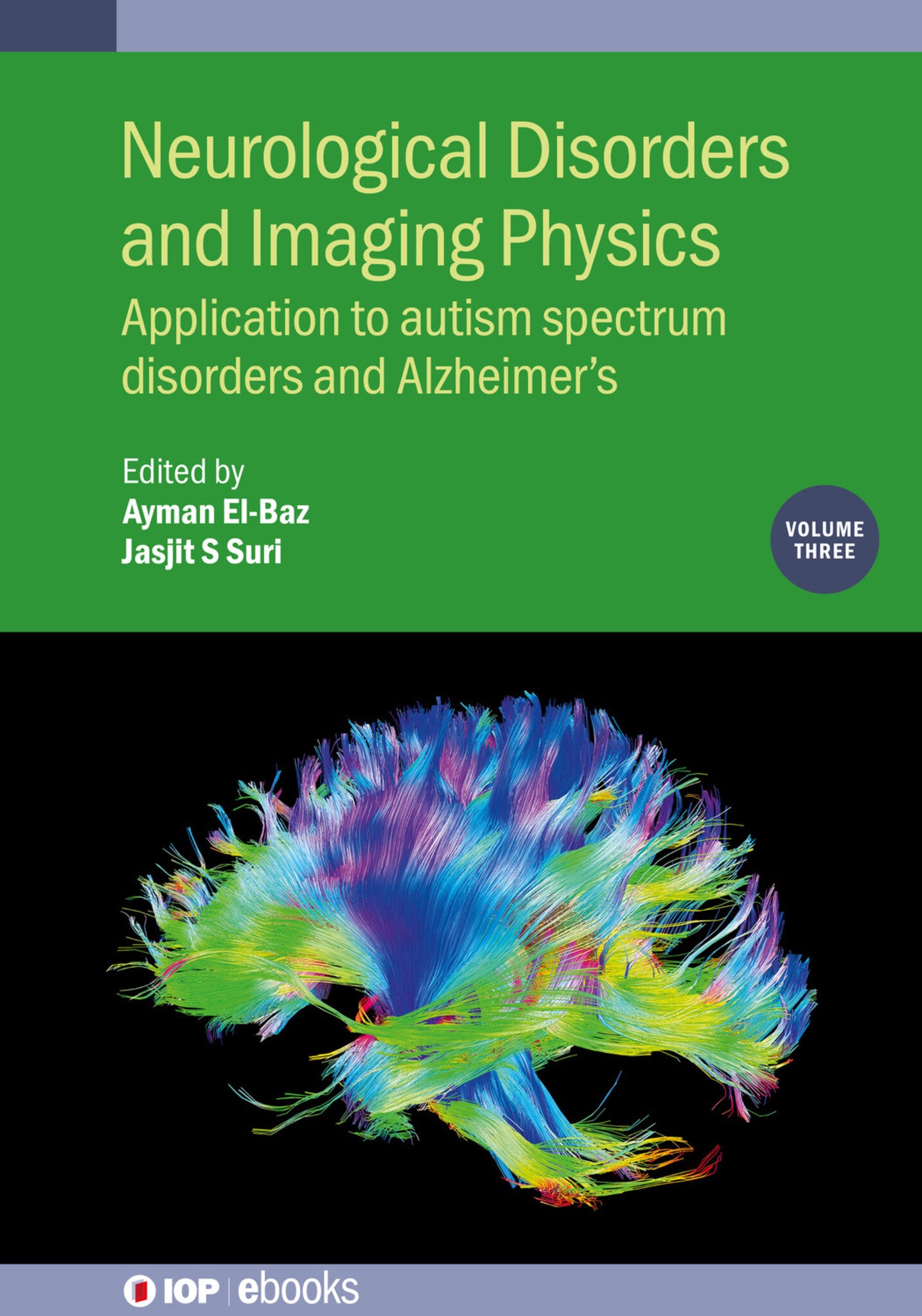We're sorry. An error has occurred
Please cancel or retry.
Neurological Disorders and Imaging Physics, Volume 3

Some error occured while loading the Quick View. Please close the Quick View and try reloading the page.
Couldn't load pickup availability
- Format:
-
15 November 2019

Autism spectrum disorder (ASD) and Alzheimer’s disease (AD) are two significant neurological disorders, which represent the scope of this book. Both ASD and AD affect a significant number of the population and present in numerous ways. This volume covers the state-of-the-art topics that investigate these two significant neurological disorders from a theoretical perspective and focuses on the practical aspects. Materials are presented in a way that can be beneficial to advanced and layman readers and several cutting-edge machine learning techniques for the early diagnosis of ASD are presented in this book. Also, various studies are discussed to demonstrate the formation, cause, and medical treatments for the AD foetal disorder.

TECHNOLOGY & ENGINEERING / Biomedical, Biomedical engineering

The funding of the collected and shared data of this article was provided by the Alzheimer’s Disease Neuroimaging Initiative (ADNI) (National Institutes of Health Grant U01 AG024904) and DOD ADNI (Department of Defense award number W81XWH-12-2-0012). ADNI is funded by the National Institute on Aging, the National Institute of Biomedical Imaging and Bioengineering, and through Neurological Disorders and Imaging Physics, Volume 3 11-14 generous contributions from the following: AbbVie, Alzheimer’s Association; Alzheimer’s Drug Discovery Foundation; Araclon Biotech; BioClinica, Inc.; Biogen; Bristol-Myers Squibb Company; CereSpir, Inc.; Cogstate; Eisai Inc.; Elan Pharmaceuticals, Inc.; Eli Lilly and Company; EuroImmun; F. Hoffmann-La Roche Ltd and its affiliated company Genentech, Inc.; Fujirebio; GE Healthcare; IXICO Ltd.; Janssen Alzheimer Immunotherapy Research & Development, LLC.; Johnson & Johnson Pharmaceutical Research & Development LLC.; Lumosity; Lundbeck; Merck & Co., Inc.; Meso Scale Diagnostics, LLC.; NeuroRx Research; Neurotrack Technologies; Novartis Pharmaceuticals Corporation; Pfizer Inc.; Piramal Imaging; Servier; Takeda Pharmaceutical Company; and Transition Therapeutics. The Canadian Institutes of Health Research is providing funds to support ADNI clinical sites in Canada. Private sector contributions are facilitated by the Foundation for the National Institutes of Health (www.fnih.org). The grantee organization is the Northern California Institute for Research and Education, and the study is coordinated by the Alzheimer’s Therapeutic Research Institute at the University of Southern California. ADNI data are disseminated by the Laboratory for Neuro Imaging at the University of Southern California.
Data collection and sharing for this work was funded by the Alzheimer’s Disease Neuroimaging Initiative (ADNI) (National Institutes of Health Grant U01 AG024904). ADNI is funded by the National Institute on Aging, the National Institute of Biomedical Imaging and Bioengineering, and through generous contributions from the following: Abbott; Alzheimer’s Association; Alzheimer’s Drug Discovery Foundation; Amorfix Life Sciences Ltd.; AstraZeneca; Bayer HealthCare; BioClinica, Inc.; Biogen Idec Inc.; Bristol-Myers Squibb Company; Eisai Inc.; Elan Pharmaceuticals Inc.; Eli Lilly and Company; F Hoffmann-La Roche Ltd and its affiliated company Genentech, Inc.; GE Healthcare; Innogenetics, NV; IXICO Ltd.; Janssen Alzheimer Immunotherapy Research and Development, LLC.; Johnson and Johnson Pharmaceutical Research and Development LLC.; Medpace, Inc.; Merck and Co., Inc.; Meso Scale Diagnostics, LLC.; Novartis Pharmaceuticals Corporation; Pfizer Inc.; Servier; Synarc Inc.; and Takeda Pharmaceutical Company. The Canadian Institutes of Health Research is providing funds to support ADNI clinical sites in Canada. Private sector contributions are facilitated by the Foundation for the National Institutes of Health http://www.fnih.org. The grantee organization is the Northern California Institute for Research and Education, and the study is coordinated by the Alzheimer’s Disease Figure 9.11. Classification results using MKL on all projections. Neurological Disorders and Imaging Physics, Volume 3 9-17 Cooperative Study at the University of California, San Diego. ADNI data are disseminated by the Laboratory for Neuro Imaging at the University of California, Los Angeles. This research was also supported by NIH grants P30 AG010129 and K01 AG030514.
Table of Contents
Preface
Acknowledgement
Dedication
Chapter 1. Machine Learning Applications to Recognize Autism and Alzheimer’s disease
Chapter 2. Neuropathology and Neuroimaging of Alzheimer´s disease
Chapter 3. Retinal Imaging in Alzheimer’s Disease
Chapter 4. Clinically Relevant Depression And Risk Of Alzheimer Disease In Olders: Meta-Analysis Of Cohort Studies
Chapter 5. The Implication of Genetic Factors in Autism Spectrum Disorder and Alzheimer’s disease
Chapter 6. Nuclear Neurology of Autism Spectrum Disorders
Chapter 7. Ethylene and ammonia in neurobehavioral disorders
Chapter 8. Focusing on Parental Behavior Following a Diagnosis of Autism: The Important Role Parents Play and How Stress Can Impact this Role
Chapter 9. Visual saliency for medical imaging and computer-aided diagnosis
Chapter 10. The Early Diagnosis of Alzheimer’s Disease Using Advanced Biomedical Engineering Technology
Chapter 11. A Local/Regional Computer Aided System for the Diagnosis of the Mild Cognitive Impairment
Chapter 12. Identifying Alzheimer’s Disease using Feature Reduction of GLCM and Supervised Classification Techniques
Chapter 13. Current Trends and Considerations of Alzheimer’s Disease
Chapter 14. A Non-Invasive Image-Based Approach Toward an Early Diagnosis of Autism
Chapter 15. Towards a Robust CAD System for Early Diagnosis of Autism Using Structural MRI
Chapter 16. Computational Analysis Techniques: A Case Study on fMRI for Autism Spectrum Disorder
Chapter 17. Autism Diagnosis Using Task-Based Functional MRI



